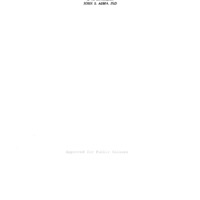-
Title
-
An Evaluation of Multiple Tracks in a Linear Program
-
Date
-
1964
-
Index Abstract
-
Not Available
-
Photo Quality
-
Not Needed
-
Report Number
-
AMRL TR 64-108
-
Creator
-
Glaser, Robert
-
Reynolds, James H.
-
Harakas, Theodore
-
Holzman, A. G.
-
Abma, John S.
-
Corporate Author
-
University of Pittsburgh
-
Laboratory
-
Behavioral Sciences Laboratory
-
Extent
-
22
-
Identifier
-
AD0609801
-
Access Rights
-
OTS
-
Distribution Classification
-
1
-
Contract
-
AF 33(616)-7175
-
DoD Project
-
1710
-
DoD Task
-
171007
-
DTIC Record Exists
-
No
-
Distribution Change Authority Correspondence
-
None
-
Distribution Conflict
-
No
-
Abstract
-
Two experiments were performed to evaluate multitracking (branching) in a linear program. In experiment one, the multitracking consisted of providing additional cues at each frame for use by those students who felt unsure of their response. Results indicated no significant difference in efficiency between the regular linear program and the multitrack program. In experiment two, the multitracking consisted of large frames followed by more detailed frames whenever the student made an error. Large frames were developed by combining an average of three small frames. Again, the results indicated no difference in instructional efficiency between the regular linear program and the multitrack program. Although more errors were made on the largestep branching program, performance on criterion tests was as good as for the regular small-step linear program. Although branching seems a reasonable way to accommodate individual differences, the two methods attempted in this research did not show an advantage. More promising methods of branching might be (a) less frequent branches, at critical points in the program, and (b) large-step frames followed by special remedial frames, rather than by mere repetition of parts of the original large frame.
-
Report Availability
-
Full text available
-
Date Issued
-
1964-10
-
Provenance
-
RAF Centre of Aviation Medicine
-
Type
-
report
-
Format
-
1 online resource
 AMRLTR64-108.pdf
AMRLTR64-108.pdf